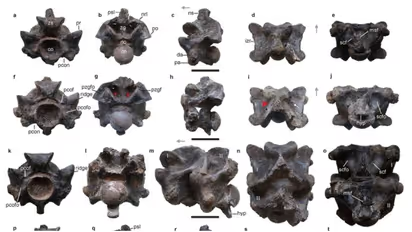HISTORIC! 50 feet Vasuki Indicus 'largest snake to have ever existed'; Kutch fossil dubbed as 'jackpot'

Synopsis
Scientists from IIT-Roorkee have uncovered the fossil of 'Vasuki Indicus,' a giant snake dating back to the Middle Eocene period, around 47 million years ago, in Gujarat, India. This serpent, measuring between 11m (36ft) and 15m (49.22ft), is believed to be the largest known madtsoiid snake and could have surpassed the size of the extinct Titanoboa.
Scientists have identified fossil vertebrae discovered in Gujarat as belonging to the largest snake ever known to have existed, surpassing even the size of the T-rex. Named 'Vasuki Indicus,' the fossil was initially unearthed in 2005 by researchers from IIT-Roorkee and has recently been confirmed as that of a colossal serpent.
The discovery of 'Vasuki Indicus' by scientists from IIT Roorkee holds the potential to provide a wealth of information on the evolutionary process, continental shifts, and India's crucial role in the origin of various species, particularly reptiles. Researchers believe that the finding could be a "jackpot" of valuable insights into these areas of study.
According to Sunil Bajpai, chair professor in IIT-Roorkee’s Department of Earth Sciences, 'Vasuki Indicus,' measuring between 11m (36ft) and 15m (about 50 feet), could have surpassed the length of the now-extinct Titanoboa, which once inhabited Colombia. The study suggests that the closest relatives of 'Vasuki Indicus' are Titanoboa and Python.
The fossil has been named after Vasuki, the snake king associated with Lord Shiva, and is referred to as 'Vasuki Indicus.'
The size of 'Vasuki Indicus' rivals that of Titanoboa, a prehistoric snake that inhabited Colombia approximately 60 million years ago. Titanoboa measured about 43 feet in length and weighed more than one tonne.
The study titled "Largest known madtsoiid snake from warm Eocene period of India suggests intercontinental Gondwana dispersal" was published in 'Scientific Reports' on the Springer Nature platform on Friday.
Bajpai and post-doctoral fellow Debajit Datta from IIT-Roorkee revealed that the fossil of this snake, retrieved from the Panandhro Lignite Mine in Kutch, dates back to the Middle Eocene period, approximately 47 million years ago. During their exploration, the researchers uncovered 27 well-preserved vertebrae believed to be from a fully-grown reptile. Its considerable length establishes it as the largest known madtsoiid snake, thriving during a warm geological interval with average temperatures estimated at 28°C.
The scientists assert that through comparative analysis of its inter-relationships with other Indian and North African madtsoiids, 'Vasuki' signifies a now-extinct relic lineage originating in India. They propose that the subsequent collision between India and Asia facilitated the intercontinental dispersal of this lineage from the Indian subcontinent into North Africa via southern Eurasia.
Stay updated with the Breaking News Today and Latest News from across India and around the world. Get real-time updates, in-depth analysis, and comprehensive coverage of India News, World News, Indian Defence News, Kerala News, and Karnataka News. From politics to current affairs, follow every major story as it unfolds. Get real-time updates from IMD on major cities weather forecasts, including Rain alerts, Cyclone warnings, and temperature trends. Download the Asianet News Official App from the Android Play Store and iPhone App Store for accurate and timely news updates anytime, anywhere.